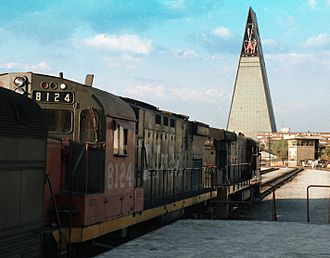Torre Insignia facts for kids
Quick facts for kids Torre Insignia |
|
|---|---|
 |
|
| Alternative names | Torre Banobras, Nonoalco Tlatelolco Tower |
| General information | |
| Location | Mexico City, Mexico |
| Coordinates | 19°27′16″N 99°09′04″W / 19.4545369°N 99.1511089°W |
| Construction started | 1958 |
| Completed | 1962 |
| Height | |
| Roof | 127 m (417 ft) |
| Technical details | |
| Floor count | 25 |
| Lifts/elevators | 10 |
| Design and construction | |
| Architect | Mario Pani Darqui |
The Torre Insignia is a famous building in Mexico City. It is also known as Torre Banobras or the Nonoalco Tlatelolco Tower. A famous architect named Mario Pani Darqui designed it. You can find it in the Tlatelolco housing complex in Cuauhtémoc.
When it was finished in 1962, Torre Insignia was the second tallest building in Mexico. Only the Torre Latinoamericana was taller. Today, the tower is not being used, but it is being fixed up. It is the tallest building in the Tlatelolco area. It is also the third tallest on Avenida Insurgentes. The building used to be the main office for a bank called Banobras. Torre Insignia has a cool triangular shape. It is built with strong concrete. It has been updated a few times. It is one of the most important buildings in Mexico City. It also has the tallest carillon in the world. A carillon is a musical instrument with many bells. This one has 47 bells made by a company called Petit & Fritsen.
Contents
What Makes Torre Insignia Special?
- The tower is 127 m (417 ft) tall. That's about the height of a 40-story building!
- It has 25 floors.
- It looks like a triangular prism. Imagine a triangle stretched upwards.
- This unique shape has made the building a symbol of Mexico City. Especially for the Avenida Insurgentes Norte area.
- The logo for the Metro Tlatelolco station even shows the building's shape. The station is very close to the tower.
- The building's total floor space is huge. It covers 22,033 square metres (236,806 square feet).
- A special musical instrument called a carillon is at the very top. It was a gift from the Belgian government to Mexico City.
- On one side of the tower, you can find the Metrobús Manuel González station.
A Look at Its History
Mexico City grew very fast, especially the Tlatelolco area. People needed more places to live and work. So, they started building tall buildings. These buildings had more than 20 floors.
Building tall towers in this area was a challenge. This is because Mexico City is in an seismic zone. This means it can have earthquakes. Construction on Torre Insignia began in 1959. It was finished by 1962. It was one of the first buildings in Mexico City to use special technology. This technology helped it stand strong during earthquakes.
Torre Insignia was the main office for the government bank Banobras. But after the big 1985 Mexico City earthquake, the building was left empty. It stayed empty for many years. In 2007, it was sold to a company called Cushman & Wakefield.
Standing Strong Against Earthquakes
Torre Insignia is known for being very strong. It has survived many big earthquakes without damage.
- The 1985 Mexico City earthquake was 8.0 on the Richter Scale. The tower was fine.
- It also survived quakes in 1995 (7.7), 1999 (7.4), 2003 (7.6), 2007 (6.3), and 2017.
- Many people think it is one of the safest buildings in Mexico City. It is even considered one of the safest in the world.
- Experts believe the building could even survive an earthquake as strong as 8.5 on the Richter Scale.
- The building was made using strong materials. These include reinforced concrete, glass, and aluminum.
- Its pyramid-like shape and strong concrete structure help it stay safe. It has been remodeled twice to keep it strong.
See also
 In Spanish: Torre Insignia para niños
In Spanish: Torre Insignia para niños

